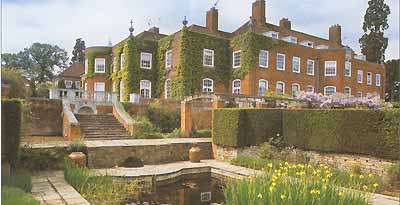 |
||||||||||||
|
|
||||||||||||
 |
||||||||||||
|
|
||||||||||||
| Stockgrove house was originally built on the site of a house of c. 1835 for Colonel Henry Hanmer. It is one of the largest country houses built between the two World Wars. It was built for Ferdinand Michael Kroyer-Kielberg K.B.E. who purchased the Stockgrove Estate on 7th September 1928, and had the Stockgrove Mansion and estate houses re-built in a mock-Georgian style.
The main entrance to the estate can be found at Rushmere, which is just in Bedfordshire, although today the main thoroughfare appears to be via the North Lodges on the Heath Road. Unlike the Duncombes and the Duke and Duchess of Bedford, the Kielbergs were considered new money in society, and the two classes never usually mixed socially. But the Kroyer-Kielbergs had their place amongst the older families in England. Sir Michael and Lady Kielberg had 3 children, a daughter Marion who lived with her husband and 2 children in the Lodge in Great Brickhill, she died of diptheria at the age of 35 years in 1950. Sir Michael had already lost his eldest son, a flight pilot in the war, The only son that remained was said to be a "wild playboy" in his mid-twenties. The Stockgrove Estate was self-sufficient; it employed many workers, including gardeners, one of who was Herbert Bates from Great Brickhill. During the war Herbert, along with Mr. Scott, the Head Gardener, kept the estate garden in order, although they would normally have retired in peace years. Waldrick's Farm, now Stockgrove Farm, supplied the estate with milk and butter and eggs and bread came from the Bakery in Great Brickhill. The Kielbergs lived in London, but resided in the Dower House when they visited at weekends. During the war the mansion was occupied by the war department, German prisoners of war were brought in from Leighton Buzzard to hand-dig trenches to allow electricity to be installed to the estate. Mrs. Marie McTigue recalls: "The war had been over a year, but some prisoners still had not returned to Germany, because there was simply nowhere to go. They had no homes or families to return to. I felt rather sorry for them, despite everything, one was only a lad not long out of his teens, and the other a man in his 50's drifted into the army I suppose, when Germany were desperate for men toward the end of the war. They had hardly any English, but indicated they needed to earn a few shillings to buy tobacco. In return they made slippers of string (used for binding corn sheaves together) the slippers lasted very well and Luke (her husband an estate form worker) and I wore them for 2 or 3 years." The estate workers would supplement their supplies by walking to the shops in Great Brickhill. Stockgrove was plentiful in wildlife. It was renowned for its bats, rare moths and glow-worms. Much of the estate was sold by Sir Michael and bought by Leslie Neville-Long on 10 May 1949, who resided in the Dower House. He, in turn, sold the mansion to London County Council (L.C.C.) which was succeeded by the Greater London Council. (G.L.C). The house became a school for children with special educational needs until the G.LC split and the school was taken over by Camden Borough Council in the 1970s. Stockgrove House was sold to developers in 1996, and now comprises luxury apartments. Sadly, Sir Michael died in 1959, an excerpt from The Times obituary stated:- Later he was Naturalised (1926). In 1926 also, he founded United Molasses, by merging 2 other companies he had also started. He retired in 1953 when he had also left the Directors Boards of two other members of the company's group: Anthey Heine and Tankers. For a number of years Sir Michael was chairman of the Anglo/Danish Society. Under his leadership during the war the society played an important part in supporting the Free Denmark Movement. He also served as Danish Ambassador to the Court of St. James . He was knighted in 1947, his gifts to charity were generous. 1928: £25,000 to the miners fund, £10,000 to the British Legion Appeal, and many other gifts to Charity that went unrecorded." |
||||||||||||
 |
||||||||||||
 |
||||||||||||